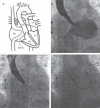Pacing and Defibrillators in Complex Congenital Heart Disease
- PMID: 27403295
- PMCID: PMC4939312
- DOI: 10.15420/aer.2016.2.3
Pacing and Defibrillators in Complex Congenital Heart Disease
Abstract
Device therapy in the complex congenital heart disease (CHD) population is a challenging field. There is a myriad of devices available, but none designed specifically for the CHD patient group, and a scarcity of prospective studies to guide best practice. Baseline cardiac anatomy, prior surgical and interventional procedures, existing tachyarrhythmias and the requirement for future intervention all play a substantial role in decision making. For both pacing systems and implantable cardioverter defibrillators, numerous factors impact on the merits of system location (endovascular versus non-endovascular), lead positioning, device selection and device programming. For those with Fontan circulation and following the atrial switch procedure there are also very specific considerations regarding access and potential complications. This review discusses the published guidelines, device indications and the best available evidence for guidance of device implantation in the complex CHD population.
Keywords: Congenital heart disease; arrhythmia; cardiac resynchronisation therapy; implantable cardioverter defibrillator; pacing; sudden cardiac death.
Figures
Similar articles
-
Complications of permanent cardiac pacing in patients with persistent left superior vena cava.Cardiol J. 2014;21(2):128-37. doi: 10.5603/CJ.a2014.0006. Epub 2014 Feb 14. Cardiol J. 2014. PMID: 24526508
-
The effect of intermittent atrial tachyarrhythmia on heart failure or death in cardiac resynchronization therapy with defibrillator versus implantable cardioverter-defibrillator patients: a MADIT-CRT substudy (Multicenter Automatic Defibrillator Implantation Trial With Cardiac Resynchronization Therapy).J Am Coll Cardiol. 2014 Apr 1;63(12):1190-1197. doi: 10.1016/j.jacc.2013.10.074. Epub 2013 Dec 11. J Am Coll Cardiol. 2014. PMID: 24333490 Clinical Trial.
-
Implantable cardioverter-defibrillator: present and future indications.Arch Mal Coeur Vaiss. 1996 Feb;89 Spec No 1:141-7. Arch Mal Coeur Vaiss. 1996. PMID: 8734176 Review.
-
[The automatic implantable cardioverter-defibrillator for prevention of sudden heart death in children and adolescents].Z Kardiol. 1993 Aug;82(8):466-73. Z Kardiol. 1993. PMID: 8212779 German.
-
Electrophysiology issues in adult congenital heart disease.Methodist Debakey Cardiovasc J. 2011 Apr-Jun;7(2):13-7. doi: 10.14797/mdcj-7-2-13. Methodist Debakey Cardiovasc J. 2011. PMID: 21685842 Review.
Cited by
-
Angiography-guided mid/high septal implantation of ventricular leads in patients with congenital heart disease.J Arrhythm. 2021 Sep 17;37(6):1512-1521. doi: 10.1002/joa3.12636. eCollection 2021 Dec. J Arrhythm. 2021. PMID: 34887956 Free PMC article.
-
Retrievable dual-chamber leadless pacemaker implant (Aveir DR) in an adult patient with congenital heart disease.Indian Pacing Electrophysiol J. 2024 Nov-Dec;24(6):347-350. doi: 10.1016/j.ipej.2024.09.001. Epub 2024 Sep 4. Indian Pacing Electrophysiol J. 2024. PMID: 39241910 Free PMC article.
-
Dual-chamber leadless pacemaker in complex adult congenital heart disease: a case report.Eur Heart J Case Rep. 2024 Sep 17;8(10):ytae506. doi: 10.1093/ehjcr/ytae506. eCollection 2024 Oct. Eur Heart J Case Rep. 2024. PMID: 39430679 Free PMC article.
-
Implantable cardioverter-defibrillators in congenital heart disease.Herzschrittmacherther Elektrophysiol. 2016 Jun;27(2):95-103. doi: 10.1007/s00399-016-0437-3. Epub 2016 Jun 1. Herzschrittmacherther Elektrophysiol. 2016. PMID: 27250725 Free PMC article. Review.
-
Pediatric Epicardial Devices: Early and Midterm Outcomes.World J Pediatr Congenit Heart Surg. 2023 Jul;14(4):451-458. doi: 10.1177/21501351231157374. Epub 2023 Feb 27. World J Pediatr Congenit Heart Surg. 2023. PMID: 36851830 Free PMC article.
References
-
- Warnes CA, Williams RG, Bashore TM, et al. ACC/AHA 2008 Guidelines for the management of adults with congenital heart disease: a report of the American College of Cardiology/American Heart Association Task Force on Practice Guidelines. Circulation. 2008;118:e714––e833. DOI: 10.1161/CIRCULATIONAHA.108.190690; PMID: 18997169. - PubMed
-
- Khairy P, Van Hare GF, Balaji S et al. PACES/HRS expert consensus statement on the recognition and management of arrhythmias in adult congenital heart disease. Heart Rhythm. 2014;11:e102––e65. DOI: 10.1016/j.hrthm.2014.05.009; PMID: 24814377. - PubMed
-
- Bhatt AB, Foster E, Kuehl K, et al. Congenital Heart Disease in the Older Adult A Scientific Statement From the American Heart Association. Circulation. 2015;131 1884-931 DOI: 10.1161/CIR.0000000000000204; PMID: 25896865. - PubMed
-
- Czosek RJ, Anderson J, Khoury PR, et al. Utility of ambulatory monitoring in patients with congenital heart disease. Am J Cardiol. 2013;111:723–30. DOI: 10.1016/j.amjcard.2012.11.021; PMID: 23246250. - PubMed
-
- Khairy P, Aboulhosn J, Gurvitz MZ et al. for the Alliance for Adult Research in Congenital Cardiology (AARCC). Arrhythmia burden in adults with surgically repaired tetralogy of Fallot: A Multi-Institutional Study. Circulation. 2010;122:868–75. DOI: 10.1161/CIRCULATIONAHA.109.928481; PMID: 20713900. - PubMed
LinkOut - more resources
Full Text Sources
Other Literature Sources




